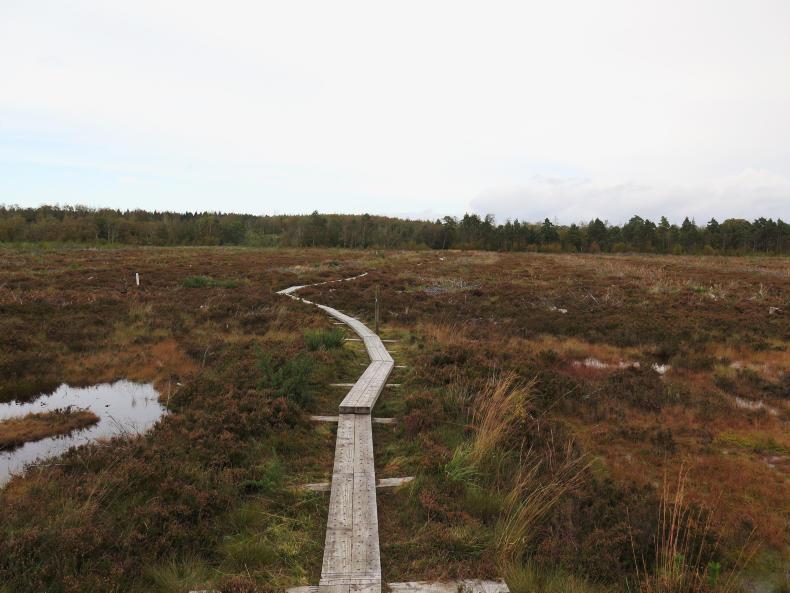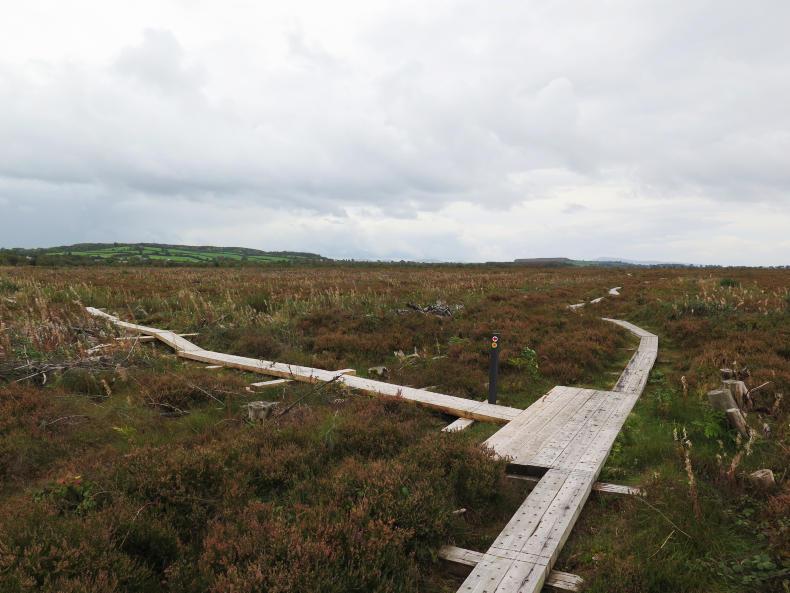Management of Ireland’s bogs and peatlands has always been a sticky subject. Politicians such as MEP Luke ‘Ming’ Flanagan and TD Michael Fitzmaurice have risen to prominence on the back of their stout defence of turf cutters’ rights.
Between 1997 and 2004 a total of 128 raised bogs were deemed Special Areas of Conservation (SAC) or National Heritage Areas (NHA) by state agencies. These designations prohibited turf cutting and peat extraction, but a series of derogations and compensation packages were designed to ease the blow to those working on the bogs.

Plastic dam in Scohaboy Bog installed as part of the rewetting process.
The issue of bogs and peatlands has resurfaced in light of Ireland’s greenhouse gas emissions targets. According to the EPA, emissions from soils account for over 28% of Ireland’s total agricultural greenhouse gas emissions. A large proportion of this is to do with the way peatlands are being managed.
Peat soils, by their nature, are extremely high in carbon. They are a major carbon sink, with active peatlands sequestering carbon from the atmosphere and putting it into the soil.
In their natural state, peatlands are wet and anaerobic (no air). Disturbing peatlands through drainage, cultivation or forestry dries out the peat and makes it aerobic, which releases the carbon back into the atmosphere, thereby increasing greenhouse gas emissions.
The harvesting and burning of peat for energy, heat or bedding carries a very high environmental footprint.

Plastic dams installed at Scohaboy Bog in Co Tipperary as part of the rewetting process.
In Budget 2020, Minister for Finance Paschal Donohoe promised special aid packages for the midlands region, as it moves towards a post peat harvesting era.
The biggest culprits in the destruction of peatlands have been the state-owned companies Bord na Móna and Coillte.
It is estimated that at one point there was over 300,000ha of raised bog in Ireland. According to a report issued in 2010, only 1% of the original area of raised bog remains.
The priority now is to conserve the remaining raised bogs and try to restore the damaged peatland. Re-wetting of bogs is a stated priority of Bord na Móna and is part of Ireland’s climate change mitigation strategy.

Scohaboy Bog
Scohaboy Bog near Cloughjordan, Co Tipperary is an example of a successful conservation and restoration project on a raised bog. The bog is one of 17 Coillte-owned sites around the country that is part of the LIFE-Nature conservation project.
The aims of the project are to protect and enhance the existing bog and to return other sections of the bog to a wetland and peat forming state. Chair of Cloughjordan Community Development Committee Gearoid O Foighill says it was a community effort.
“We all worked together to make it happen. We met with local farmers who had turbary rights to cut turf on the bog. We explained what our plans were, what we hoped to achieve and why it was important. We brought people with us through dialogue and communication, as opposed to imposing change,” O Foighill says.
The 214ha of Scohaboy Bog is adjacent to the Coillte-owned Sopwell Wood. Part of the wood extended out into the bog.
Restoration
O Foighill says the original plan was to plant the whole bog in the 1980s, but when a track machine was lost in the bog, the foresters had to abandon their plans.
As part of the restoration project, the conifer trees on the bog have been cut down and removed. Drains, which were installed when the trees were planted, have been closed off through the construction of peat dams and the insertion of hundreds of plastic dams. The dams block the flow of water and keep the bog wet. Removing the trees increases the amount of water in the bog, as trees soak up a lot of water.
The aim of re-wetting is to create the conditions for sphagnum moss to grow. Sphagnum is a peat-forming moss and it’s now widespread throughout Scohaboy, which is a definitive sign of a healthy, living bog. It builds peat at a rate of 1mm per year, so 1m of peat takes 1,000 years to form.
A timber walkway has been built through the bog and Scohaboy is now a popular walking spot for locals and tourists. Maintenance of the bog involves removing new pine seedlings and keeping as much water in the bog as possible. Sphagnum moss will only grow in wet, anaerobic conditions.
The success of the Cloughjordan project is now seen as a model for other communities to follow. Considering the amount of carbon lost through soils in Ireland, we can expect to see much more re-wetting of peatland in years to come.
Read more
Peatland used for agriculture should be ‘targeted’ for rewetting
Opposition to turf cutter relocation
Management of Ireland’s bogs and peatlands has always been a sticky subject. Politicians such as MEP Luke ‘Ming’ Flanagan and TD Michael Fitzmaurice have risen to prominence on the back of their stout defence of turf cutters’ rights.
Between 1997 and 2004 a total of 128 raised bogs were deemed Special Areas of Conservation (SAC) or National Heritage Areas (NHA) by state agencies. These designations prohibited turf cutting and peat extraction, but a series of derogations and compensation packages were designed to ease the blow to those working on the bogs.

Plastic dam in Scohaboy Bog installed as part of the rewetting process.
The issue of bogs and peatlands has resurfaced in light of Ireland’s greenhouse gas emissions targets. According to the EPA, emissions from soils account for over 28% of Ireland’s total agricultural greenhouse gas emissions. A large proportion of this is to do with the way peatlands are being managed.
Peat soils, by their nature, are extremely high in carbon. They are a major carbon sink, with active peatlands sequestering carbon from the atmosphere and putting it into the soil.
In their natural state, peatlands are wet and anaerobic (no air). Disturbing peatlands through drainage, cultivation or forestry dries out the peat and makes it aerobic, which releases the carbon back into the atmosphere, thereby increasing greenhouse gas emissions.
The harvesting and burning of peat for energy, heat or bedding carries a very high environmental footprint.

Plastic dams installed at Scohaboy Bog in Co Tipperary as part of the rewetting process.
In Budget 2020, Minister for Finance Paschal Donohoe promised special aid packages for the midlands region, as it moves towards a post peat harvesting era.
The biggest culprits in the destruction of peatlands have been the state-owned companies Bord na Móna and Coillte.
It is estimated that at one point there was over 300,000ha of raised bog in Ireland. According to a report issued in 2010, only 1% of the original area of raised bog remains.
The priority now is to conserve the remaining raised bogs and try to restore the damaged peatland. Re-wetting of bogs is a stated priority of Bord na Móna and is part of Ireland’s climate change mitigation strategy.

Scohaboy Bog
Scohaboy Bog near Cloughjordan, Co Tipperary is an example of a successful conservation and restoration project on a raised bog. The bog is one of 17 Coillte-owned sites around the country that is part of the LIFE-Nature conservation project.
The aims of the project are to protect and enhance the existing bog and to return other sections of the bog to a wetland and peat forming state. Chair of Cloughjordan Community Development Committee Gearoid O Foighill says it was a community effort.
“We all worked together to make it happen. We met with local farmers who had turbary rights to cut turf on the bog. We explained what our plans were, what we hoped to achieve and why it was important. We brought people with us through dialogue and communication, as opposed to imposing change,” O Foighill says.
The 214ha of Scohaboy Bog is adjacent to the Coillte-owned Sopwell Wood. Part of the wood extended out into the bog.
Restoration
O Foighill says the original plan was to plant the whole bog in the 1980s, but when a track machine was lost in the bog, the foresters had to abandon their plans.
As part of the restoration project, the conifer trees on the bog have been cut down and removed. Drains, which were installed when the trees were planted, have been closed off through the construction of peat dams and the insertion of hundreds of plastic dams. The dams block the flow of water and keep the bog wet. Removing the trees increases the amount of water in the bog, as trees soak up a lot of water.
The aim of re-wetting is to create the conditions for sphagnum moss to grow. Sphagnum is a peat-forming moss and it’s now widespread throughout Scohaboy, which is a definitive sign of a healthy, living bog. It builds peat at a rate of 1mm per year, so 1m of peat takes 1,000 years to form.
A timber walkway has been built through the bog and Scohaboy is now a popular walking spot for locals and tourists. Maintenance of the bog involves removing new pine seedlings and keeping as much water in the bog as possible. Sphagnum moss will only grow in wet, anaerobic conditions.
The success of the Cloughjordan project is now seen as a model for other communities to follow. Considering the amount of carbon lost through soils in Ireland, we can expect to see much more re-wetting of peatland in years to come.
Read more
Peatland used for agriculture should be ‘targeted’ for rewetting
Opposition to turf cutter relocation









 This is a subscriber-only article
This is a subscriber-only article










SHARING OPTIONS: